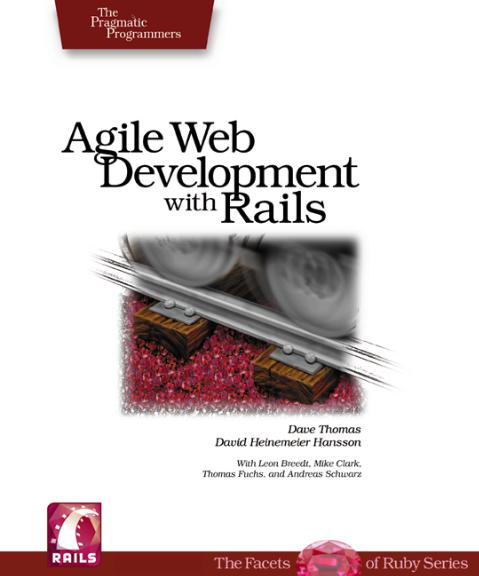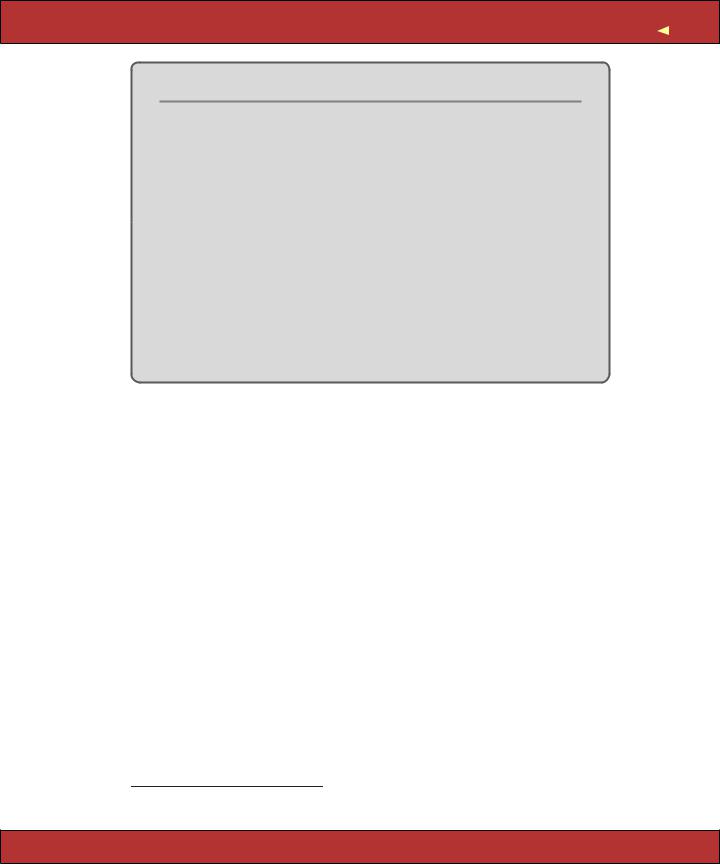
- •Introduction
- •Rails Is Agile
- •Finding Your Way Around
- •Acknowledgments
- •Getting Started
- •Models, Views, and Controllers
- •Installing Rails
- •Installing on Windows
- •Installing on Mac OS X
- •Installing on Unix/Linux
- •Rails and Databases
- •Keeping Up-to-Date
- •Rails and ISPs
- •Creating a New Application
- •Hello, Rails!
- •Linking Pages Together
- •What We Just Did
- •Building an Application
- •The Depot Application
- •Incremental Development
- •What Depot Does
- •Task A: Product Maintenance
- •Iteration A1: Get Something Running
- •Iteration A2: Add a Missing Column
- •Iteration A4: Prettier Listings
- •Task B: Catalog Display
- •Iteration B1: Create the Catalog Listing
- •Iteration B2: Add Page Decorations
- •Task C: Cart Creation
- •Sessions
- •More Tables, More Models
- •Iteration C1: Creating a Cart
- •Iteration C3: Finishing the Cart
- •Task D: Checkout!
- •Iteration D2: Show Cart Contents on Checkout
- •Task E: Shipping
- •Iteration E1: Basic Shipping
- •Task F: Administrivia
- •Iteration F1: Adding Users
- •Iteration F2: Logging In
- •Iteration F3: Limiting Access
- •Finishing Up
- •More Icing on the Cake
- •Task T: Testing
- •Tests Baked Right In
- •Testing Models
- •Testing Controllers
- •Using Mock Objects
- •Test-Driven Development
- •Running Tests with Rake
- •Performance Testing
- •The Rails Framework
- •Rails in Depth
- •Directory Structure
- •Naming Conventions
- •Active Support
- •Logging in Rails
- •Debugging Hints
- •Active Record Basics
- •Tables and Classes
- •Primary Keys and IDs
- •Connecting to the Database
- •Relationships between Tables
- •Transactions
- •More Active Record
- •Acts As
- •Aggregation
- •Single Table Inheritance
- •Validation
- •Callbacks
- •Advanced Attributes
- •Miscellany
- •Action Controller and Rails
- •Context and Dependencies
- •The Basics
- •Routing Requests
- •Action Methods
- •Caching, Part One
- •The Problem with GET Requests
- •Action View
- •Templates
- •Builder templates
- •RHTML Templates
- •Helpers
- •Formatting Helpers
- •Linking to Other Pages and Resources
- •Pagination
- •Form Helpers
- •Layouts and Components
- •Adding New Templating Systems
- •Introducing AJAX
- •The Rails Way
- •Advanced Techniques
- •Action Mailer
- •Sending E-mail
- •Receiving E-mail
- •Testing E-mail
- •Web Services on Rails
- •Dispatching Modes
- •Using Alternate Dispatching
- •Method Invocation Interception
- •Testing Web Services
- •Protocol Clients
- •Securing Your Rails Application
- •SQL Injection
- •Cross-Site Scripting (CSS/XSS)
- •Avoid Session Fixation Attacks
- •Creating Records Directly from Form Parameters
- •Knowing That It Works
- •Deployment and Scaling
- •Picking a Production Platform
- •A Trinity of Environments
- •Iterating in the Wild
- •Maintenance
- •Finding and Dealing with Bottlenecks
- •Case Studies: Rails Running Daily
- •Appendices
- •Introduction to Ruby
- •Ruby Names
- •Regular Expressions
- •Source Code
- •Cross-Reference of Code Samples
- •Resources
- •Index

Prepared exclusively for Rida Al Barazi

Agile Web Development with Rails
A Pragmatic Guide
Dave Thomas
David Heinemeier Hansson
with Leon Breedt Mike Clark Thomas Fuchs Andreas Schwarz
The Pragmatic Bookshelf
Raleigh, North Carolina Dallas, Texas
Prepared exclusively for Rida Al Barazi

Pragmatic
Bookshelf
Many of the designations used by manufacturers and sellers to distinguish their products are claimed as trademarks. Where those designations appear in this book, and The Pragmatic Programmers, LLC was aware of a trademark claim, the designations have been printed in initial capital letters or in all capitals. The Pragmatic Starter Kit, The Pragmatic Programmer, Pragmatic Programming, Pragmatic Bookshelf and the linking g device are trademarks of The Pragmatic Programmers, LLC.
Every precaution was taken in the preparation of this book. However, the publisher assumes no responsibility for errors or omissions, or for damages that may result from the use of information (including program listings) contained herein.
Our Pragmatic courses, workshops, and other products can help you and your team create better software and have more fun. For more information, as well as the latest Pragmatic titles, please visit us at
http://www.pragmaticprogrammer.com
Copyright © 2005 The Pragmatic Programmers LLC.
All rights reserved.
No part of this publication may be reproduced, stored in a retrieval system, or transmitted, in any form, or by any means, electronic, mechanical, photocopying, recording, or otherwise, without the prior consent of the publisher.
Printed in the United States of America.
ISBN 0-9766940-0-X
Printed on acid-free paper with 85% recycled, 30% post-consumer content.
First printing, July 2005
Version: 2005-7-13
Prepared exclusively for Rida Al Barazi

Contents
1 Introduction |
|
1 |
|
1.1 |
Rails Is Agile . . . . . . . . |
. . . . . . . . . . . . . . . . . . . |
3 |
1.2 |
Finding Your Way Around |
. . . . . . . . . . . . . . . . . . . |
4 |
1.3 |
Acknowledgments . . . . . |
. . . . . . . . . . . . . . . . . . . |
6 |
Part I—Getting Started |
|
|
8 |
||
2 The Architecture of Rails Applications |
|
9 |
|||
|
2.1 |
Models, Views, and Controllers |
. . . . . . . . . . . . . |
. . . |
9 |
|
2.2 |
Active Record: Rails Model Support . . . . . . . . . . |
. . . |
13 |
|
|
2.3 |
Action Pack: The View and Controller . . . . . . . . . |
. . . |
17 |
|
3 |
Installing Rails |
|
|
19 |
|
|
3.1 |
Installing on Windows . . . . . . . . . . . . . . . . . . |
. . . |
19 |
|
|
3.2 |
Installing on Mac OS X . . . . . |
. . . . . . . . . . . . . |
. . . |
20 |
|
3.3 |
Installing on Unix/Linux . . . . |
. . . . . . . . . . . . . |
. . . |
20 |
|
3.4 |
Rails and Databases . . . . . . |
. . . . . . . . . . . . . |
. . . |
21 |
|
3.5 |
Keeping Up-to-Date . . . . . . . |
. . . . . . . . . . . . . |
. . . |
24 |
|
3.6 |
Rails and ISPs . . . . . . . . . . |
. . . . . . . . . . . . . |
. . . |
24 |
4 |
Instant Gratification |
|
|
25 |
|
|
4.1 |
Creating a New Application . . . . . . . . . . . . . . . |
. . . |
25 |
|
|
4.2 |
Hello, Rails! . . . . . . . . . . . |
. . . . . . . . . . . . . |
. . . |
27 |
|
4.3 |
Linking Pages Together . . . . . |
. . . . . . . . . . . . . |
. . . |
37 |
|
4.4 |
What We Just Did . . . . . . . . |
. . . . . . . . . . . . . |
. . . |
41 |
Prepared exclusively for Rida Al Barazi

CONTENTS  v
v
Part II—Building an Application |
42 |
5 The Depot Application |
43 |
5.1Incremental Development . . . . . . . . . . . . . . . . . . . 43
5.2 |
What Depot Does . . . . . . . . |
. . . . . . . . . . . . . |
. . . |
44 |
5.3 |
Let’s Code . . . . . . . . . . . . |
. . . . . . . . . . . . . |
. . . |
48 |
6 Task A: Product Maintenance |
|
|
49 |
|
6.1 |
Iteration A1: Get Something Running . . . . . . . . . |
. . . |
49 |
|
6.2 |
Iteration A2: Add a Missing Column . . . . . . . . . . |
. . . |
57 |
|
6.3Iteration A3: Validate! . . . . . . . . . . . . . . . . . . . . . 60
6.4 Iteration A4: Prettier Listings . . . . . . . . . . . . . . . . . 63
7 |
Task B: Catalog Display |
|
|
67 |
|
|
7.1 |
Iteration B1: Create the Catalog Listing . . . . . . . . |
. . . |
67 |
|
|
7.2 |
Iteration B2: Add Page Decorations . . . . . . . . . . |
. . . |
70 |
|
8 |
Task C: Cart Creation |
|
|
74 |
|
|
8.1 |
Sessions . . . . . . . . . . . . . |
. . . . . . . . . . . . . |
. . . |
74 |
8.2More Tables, More Models . . . . . . . . . . . . . . . . . . . 76
8.3 Iteration C1: Creating a Cart . . . . . . . . . . . . . . . . . 78
8.4Iteration C2: Handling Errors . . . . . . . . . . . . . . . . . 86
8.5 Iteration C3: Finishing the Cart . . . . . . . . . . . . . . . . 90
9 |
Task D: Checkout! |
95 |
|
|
9.1 |
Iteration D1: Capturing an Order . . . . . . . . . . . . . . . |
96 |
|
9.2 |
Iteration D2: Show Cart Contents on Checkout . . . . . . |
104 |
10 |
Task E: Shipping |
109 |
|
|
10.1 |
Iteration E1: Basic Shipping . . . . . . . . . . . . . . . . . |
109 |
11 |
Task F: Administrivia |
118 |
|
|
11.1 |
Iteration F1: Adding Users . . . . . . . . . . . . . . . . . . . |
118 |
|
11.2 |
Iteration F2: Logging In . . . . . . . . . . . . . . . . . . . . |
123 |
|
11.3 |
Iteration F3: Limiting Access . . . . . . . . . . . . . . . . . |
125 |
|
11.4 |
Finishing Up . . . . . . . . . . . . . . . . . . . . . . . . . . . |
129 |
|
11.5 |
More Icing on the Cake . . . . . . . . . . . . . . . . . . . . . |
130 |
Prepared exclusively for Rida Al Barazi
Report erratum

|
|
CONTENTS |
vi |
|
12 Task T: Testing |
|
132 |
|
|
12.1 |
Tests Baked Right In . . . |
. . . . . . . . . . . . . . . . . . . |
132 |
|
12.2 |
Testing Models . . . . . . |
. . . . . . . . . . . . . . . . . . . |
133 |
|
12.3 |
Testing Controllers . . . . |
. . . . . . . . . . . . . . . . . . . |
148 |
|
12.4 |
Using Mock Objects . . . . |
. . . . . . . . . . . . . . . . . . . |
161 |
|
12.5 |
Test-Driven Development |
. . . . . . . . . . . . . . . . . . . |
162 |
|
12.6 |
Running Tests with Rake |
. . . . . . . . . . . . . . . . . . . |
165 |
|
12.7 |
Performance Testing . . . |
. . . . . . . . . . . . . . . . . . . |
168 |
|
Part III—The Rails Framework |
|
172 |
|
13 Rails in Depth |
|
173 |
|
13.1 |
So Where’s Rails? . . . . . . . . |
. . . . . . . . . . . . . . . . |
173 |
13.2 |
Directory Structure . . . . . . . |
. . . . . . . . . . . . . . . . |
173 |
13.3 |
Rails Configuration . . . . . . . |
. . . . . . . . . . . . . . . . |
177 |
13.4 |
Naming Conventions . . . . . . |
. . . . . . . . . . . . . . . . |
180 |
13.5 |
Active Support . . . . . . . . . . |
. . . . . . . . . . . . . . . . |
184 |
13.6 |
Logging in Rails . . . . . . . . . |
. . . . . . . . . . . . . . . . |
186 |
13.7 |
Debugging Hints . . . . . . . . |
. . . . . . . . . . . . . . . . |
186 |
13.8 |
What’s Next . . . . . . . . . . . |
. . . . . . . . . . . . . . . . |
188 |
14 Active Record Basics |
|
190 |
|
14.1 |
Tables and Classes . . . . . . . |
. . . . . . . . . . . . . . . . |
191 |
14.2Columns and Attributes . . . . . . . . . . . . . . . . . . . . 192
14.3 Primary Keys and IDs . . . . . . . . . . . . . . . . . . . . . 197
14.4Connecting to the Database . . . . . . . . . . . . . . . . . . 199
14.5 CRUD—Create, Read, Update, Delete . . . . . . . . . |
. . . 201 |
14.6Relationships between Tables . . . . . . . . . . . . . . . . . 216
14.7 Transactions . . . . . . . . . . . . . . . . . . . . . . . . . . . 237
15 More Active Record |
243 |
15.1Acts As . . . . . . . . . . . . . . . . . . . . . . . . . . . . . . 243
15.2 Aggregation . . . . . . . . . . . |
. . . . . . . . . . . . . . . . 247 |
15.3Single Table Inheritance . . . . . . . . . . . . . . . . . . . . 253
15.4 |
Validation . . . . . . . . . . . . |
. . . . . . . . . . . . . . . . |
256 |
15.5 |
Callbacks . . . . . . . . . . . . . |
. . . . . . . . . . . . . . . . |
264 |
15.6 |
Advanced Attributes . . . . . . |
. . . . . . . . . . . . . . . . |
272 |
15.7 |
Miscellany . . . . . . . . . . . . |
. . . . . . . . . . . . . . . . |
275 |
Prepared exclusively for Rida Al Barazi
Report erratum

CONTENTS  vii
vii
16 Action Controller and Rails |
|
|
278 |
|
16.1 |
Context and Dependencies . . . . . . . . . . . . . . . . . . |
278 |
||
16.2 |
The Basics . . . . . . . . . . . . |
. . . . . . . . . . . . . . . . |
279 |
|
16.3 |
Routing Requests . . . . . . . . |
. . . . . . . . . . . . . . . . |
280 |
|
16.4 |
Action Methods . . . . . . . . . |
. . . . . . . . . . . . . . . . |
291 |
|
16.5 |
Cookies and Sessions . . . . . . |
. . . . . . . . . . . . . . . . |
301 |
|
16.6 |
Flash—Communicating between Actions . . . . . . . |
. . . |
311 |
|
16.7Filters and Verification . . . . . . . . . . . . . . . . . . . . . 313
16.8 |
Caching, Part One . . . . . . . |
. . . . . . . . . . . . . . . . |
318 |
|
16.9 |
The Problem with GET Requests . . . . . . . . . . . . |
. . . |
324 |
|
17 Action View |
|
|
327 |
|
17.1 |
Templates . . . . . . . . . . . . |
. . . . . . . . . . . . . . . . |
327 |
|
17.2 |
Builder templates . . . . . . . . |
. . . . . . . . . . . . . . . . |
329 |
|
17.3 |
RHTML Templates . . . . . . . |
. . . . . . . . . . . . . . . . |
330 |
|
17.4Helpers . . . . . . . . . . . . . . . . . . . . . . . . . . . . . . 332
17.5 |
Formatting Helpers . . . . . . . |
. . . . . . . . . . . . . |
. . . |
335 |
17.6 |
Linking to Other Pages and Resources . . . . . . . . . |
. . . |
337 |
|
17.7 |
Pagination . . . . . . . . . . . . |
. . . . . . . . . . . . . |
. . . |
340 |
17.8 |
Form Helpers . . . . . . . . . . |
. . . . . . . . . . . . . |
. . . |
341 |
17.9Layouts and Components . . . . . . . . . . . . . . . . . . . 356
17.10 Caching, Part Two . . . . . . . . . . . . . . . . . . . . . . . . 366 17.11 Adding New Templating Systems . . . . . . . . . . . . . . . 370
18 The Web, V2.0 |
|
373 |
|
18.1 |
Introducing AJAX . . . . . . . . |
. . . . . . . . . . . . . . . . |
373 |
18.2 |
The Rails Way . . . . . . . . . . |
. . . . . . . . . . . . . . . . |
376 |
18.3 |
The User Interface, Revisited . |
. . . . . . . . . . . . . . . . |
384 |
18.4 |
Advanced Techniques . . . . . |
. . . . . . . . . . . . . . . . |
389 |
19 Action Mailer |
|
399 |
|
19.1 |
Sending E-mail . . . . . . . . . |
. . . . . . . . . . . . . . . . |
399 |
19.2 |
Receiving E-mail . . . . . . . . |
. . . . . . . . . . . . . . . . |
406 |
19.3 |
Testing E-mail . . . . . . . . . . |
. . . . . . . . . . . . . . . . |
408 |
20 Web Services on Rails |
|
411 |
|
20.1 |
What AWS Is (and What It Isn’t) |
. . . . . . . . . . . . . . . . |
411 |
20.2 |
The API Definition . . . . . . . . |
. . . . . . . . . . . . . . . . |
412 |
20.3 |
Dispatching Modes . . . . . . . |
. . . . . . . . . . . . . . . . |
417 |
20.4 |
Using Alternate Dispatching . . |
. . . . . . . . . . . . . . . . |
420 |
20.5 |
Method Invocation Interception |
. . . . . . . . . . . . . . . . |
421 |
20.6 |
Testing Web Services . . . . . . |
. . . . . . . . . . . . . . . . |
423 |
20.7 |
Protocol Clients . . . . . . . . . |
. . . . . . . . . . . . . . . . |
425 |
Prepared exclusively for Rida Al Barazi
Report erratum

CONTENTS  viii
viii
21 Securing Your Rails Application |
|
427 |
|
21.1 |
SQL Injection . . . . . . . . . . |
. . . . . . . . . . . . . . . . |
427 |
21.2 |
Cross-Site Scripting (CSS/XSS) |
. . . . . . . . . . . . . . . . |
430 |
21.3 |
Avoid Session Fixation Attacks |
. . . . . . . . . . . . . . . . |
433 |
21.4Creating Records Directly from Form Parameters . . . . . 434
21.5 Don’t Trust ID Parameters . . . . . . . . . . . . . . . . . . . 435 21.6 Don’t Expose Controller Methods . . . . . . . . . . . . . . . 436 21.7 File Uploads . . . . . . . . . . . . . . . . . . . . . . . . . . . 438 21.8 Don’t Cache Authenticated Pages . . . . . . . . . . . . . . . 438 21.9 Knowing That It Works . . . . . . . . . . . . . . . . . . . . . 439
22 Deployment and Scaling |
440 |
22.1Picking a Production Platform . . . . . . . . . . . . . . . . . 440
22.2A Trinity of Environments . . . . . . . . . . . . . . . . . . . 448
22.3 |
Iterating in the Wild . . . . . . |
. . . . . . . . . . . . . |
. . . |
450 |
22.4 |
Maintenance . . . . . . . . . . . |
. . . . . . . . . . . . . |
. . . |
454 |
22.5 |
Scaling: The Share-Nothing Architecture . . . . . . . |
. . . |
456 |
|
22.6 |
Finding and Dealing with Bottlenecks . . . . . . . . . |
. . . |
459 |
|
22.7 |
Case Studies: Rails Running Daily . . . . . . . . . . . |
. . . |
463 |
|
Part IV—Appendices |
|
|
466 |
|
A Introduction to Ruby |
|
|
467 |
|
A.1 |
Ruby Is an Object-Oriented Language . . . . . . . . . |
. . . |
467 |
|
A.2 |
Ruby Names . . . . . . . . . . . |
. . . . . . . . . . . . . . . . |
468 |
|
A.3 |
Methods . . . . . . . . . . . . . |
. . . . . . . . . . . . . . . . |
469 |
|
A.4 |
Classes . . . . . . . . . . . . . . . . . . . . . . . . . . . . . . |
471 |
||
A.5 |
Modules . . . . . . . . . . . . . |
. . . . . . . . . . . . . . . . |
473 |
|
A.6 |
Arrays and Hashes . . . . . . . |
. . . . . . . . . . . . . . . . |
474 |
|
A.7 |
Control Structures . . . . . . . |
. . . . . . . . . . . . . . . . |
475 |
|
A.8 |
Regular Expressions . . . . . . |
. . . . . . . . . . . . . . . . |
476 |
|
A.9 |
Blocks and Iterators . . . . . . |
. . . . . . . . . . . . . . . . |
476 |
|
A.10 |
Exceptions . . . . . . . . . . . . |
. . . . . . . . . . . . . . . . |
477 |
|
A.11 |
Marshaling Objects . . . . . . . |
. . . . . . . . . . . . . . . . |
478 |
|
A.12 |
Interactive Ruby . . . . . . . . . |
. . . . . . . . . . . . . . . . |
478 |
|
A.13 |
Ruby Idioms . . . . . . . . . . . |
. . . . . . . . . . . . . . . . |
479 |
|
A.14 |
RDoc Documentation . . . . . . |
. . . . . . . . . . . . . . . . |
480 |
|
Prepared exclusively for Rida Al Barazi
Report erratum

CONTENTS  ix
ix
B Configuration Parameters |
482 |
B.1 Active Record Configuration . . . . . . . . . . . . . . . . . . 482 B.2 Action Pack Configuration . . . . . . . . . . . . . . . . . . . 483 B.3 Action Mailer Configuration . . . . . . . . . . . . . . . . . . 485 B.4 Test Case Configuration . . . . . . . . . . . . . . . . . . . . 485
C Source Code |
|
|
486 |
|
C.1 |
The Full Depot Application . . . . . . . . . . . . . . . . . . |
486 |
||
C.2 |
Sample System Notifier . . . . . |
. . . . . . . . . . . . . . . . |
511 |
|
C.3 |
Cross-Reference of Code Samples . . . . . . . . . . . |
. . . |
512 |
|
D Resources |
|
516 |
|
D.1 |
Online Resources . . . . . . . . |
. . . . . . . . . . . . . . . . |
516 |
D.2 |
Bibliography . . . . . . . . . . . |
. . . . . . . . . . . . . . . . |
516 |
Index |
|
|
517 |
Prepared exclusively for Rida Al Barazi
Report erratum

By relieving the brain of all unnecessary work, a good notation sets it free to concentrate on more advanced problems...
 Alfred North Whitehead
Alfred North Whitehead
Chapter 1
Introduction
Ruby on Rails is a framework that makes it easier to develop, deploy, and maintain web applications.
Of course, all web frameworks make the same claim. What makes Rails different? We can answer that question a number of ways.
One way is to look at architecture. Over time, most developers have moved to a Model-View-Controller (MVC) architecture for serious web applications. They find that MVC helps them structure their applications more cleanly. (We discuss MVC in more detail in the next chapter.) Java frameworks such as Tapestry and Struts are based on MVC. Rails is an MVC framework, too. When you develop in Rails, there’s a place for each piece of code, and all the pieces of your application interact in a standard way. It’s as if you start out with the skeleton of an application already prepared.
Another way of answering the question is to look at the programming language. Rails applications are written in Ruby, a modern, object-oriented scripting language. Ruby is concise without being unintelligibly terse— you can express ideas naturally and cleanly in Ruby code. This leads to programs that are easy to write and (just as importantly) are easy to read months later.
Ruby also lends itself to a style of programming that’s familiar to Lisp coders, but will look fairly exotic to others. The language makes it easy to create methods that act almost like extensions to the syntax. Some folks call this metaprogramming, but we just call it useful. It makes our programs shorter and more readable. It also allows us to perform tasks that would normally be done in external configuration files inside the codebase instead. This makes it far easier to see what’s going on. The following code defines the model class for a project. Don’t worry about the details for
Prepared exclusively for Rida Al Barazi

CHAPTER 1. INTRODUCTION |
2 |
now. Instead, just think about how much information is being expressed in a few lines of code.
class Project < ActiveRecord::Base
belongs_to |
:portfolio |
has_one |
:project_manager |
has_many |
:milestones |
has_and_belongs_to_many :categories
validates_presence_of :name, :description validates_acceptance_of :non_disclosure_agreement validates_uniqueness_of :key
end
Or we can look at philosophy. The design of Rails was driven by a couple of key concepts: DRY and convention over configuration. DRY stands for Don’t Repeat Yourself —every piece of knowledge in a system should be expressed in just one place. Rails uses the power of Ruby to bring that to life. You’ll find very little duplication in a Rails application; you say what you need to say in one place—a place often suggested by the conventions of the MVC architecture—and then move on.
Convention over configuration is crucial, too. It means that Rails has sensible defaults for just about every aspect of knitting together your application. Follow the conventions and you can write a Rails application using less code than a typical Java web application uses in XML configuration. If you need to override the conventions, Rails makes that easy, too.
We could also mention all the cool stuff rolled into Rails including integrated web services support, reception of incoming e-mails, AJAX (for highly interactive web applications), a full unit testing framework (including transparent support for mock objects), and isolated environments for development, testing, and production.
Or we could talk about the code generators that come with Rails (and more that are available on the ’Net). These create Ruby code skeletons, leaving you to fill in the application’s logic.
Finally, Rails is different because of its origins—Rails was extracted from a real-world, commercial application. It turns out the best way to create a framework is to find the central themes in a specific application and then bottle them up in a generic foundation of code. When you’re developing your Rails application, you’re starting with half of a really good application already in place.
But there’s something else to Rails—something that’s hard to describe. Somehow, it just feels right. Of course you’ll have to take our word for that until you write some Rails applications for yourself (which should be in the next 45 minutes or so...). That’s what this book is all about.
Prepared exclusively for Rida Al Barazi
Report erratum

RAILS IS AGILE |
3 |
Dave’s Top 10 Reasons To Like Rails
1.It brings agility to web development.
2.I can create web pages with neat effects, just like the cool kids do.
3.It lets me focus on creating the application, not feeding the framework.
4.My applications stay maintainable as they grow.
5.I get to say “Yes” to clients more often.
6.Testing is built-in (and easy), so it gets used.
7.Instant feedback: edit the code, hit Refresh, and the change is in my browser.
8.Metaprogramming means I can program at a really high level.
9.Code generators let me get started quickly.
10.No XML!
1.1Rails Is Agile
The title of this book is Agile Web Development with Rails. You may be surprised, then, to discover that we don’t have explicit sections on applying agile practices X, Y, and Z to Rails coding.
The reason is both simple and subtle. Agility is part of the fabric of Rails.
Let’s look at the values expressed in the Agile Manifesto.1 They’re stated as a set of four preferences. Agile development favors the following.
•Individuals and interactions over processes and tools
•Working software over comprehensive documentation
•Customer collaboration over contract negotiation
•Responding to change over following a plan
Rails is all about individuals and interactions. There are no heavy toolsets, no complex configurations, and no elaborate processes. There are just small groups of developers, their favorite editors, and chunks of Ruby code. This leads to transparency; what the developers do is reflected immediately in what the customer sees. It’s an intrinsically interactive process.
1http://agilemanifesto.org/. Dave Thomas was one of the 17 authors of this document.
Prepared exclusively for Rida Al Barazi
Report erratum

FINDING YOUR WAY AROUND |
4 |
Rails doesn’t denounce documentation. Rails makes it trivially easy to create HTML documentation for your entire codebase. But the Rails development process isn’t driven by documents. You won’t find 500-page specifications at the heart of a Rails project. Instead, you’ll find a group of users and developers jointly exploring their need and the possible ways of answering that need. You’ll find solutions that change as both the developers and users become more experienced with the problems they’re trying to solve. You’ll find a framework that delivers working software early in the development cycle. This software may be rough around the edges, but it lets the users start to get a glimpse of what you’ll be delivering.
In this way, Rails encourages customer collaboration. When customers see just how quickly a Rails project can respond to change, they start to trust that the team can deliver what’s required, not just what’s been asked for. Confrontations are replaced by “What if?” sessions.
That’s all tied back to the idea of being able to respond to change. The strong, almost obsessive, way that Rails honors the DRY principle means that changes to Rails applications impact a lot less code than the same changes would in other frameworks. And since Rails applications are written in Ruby, where concepts can be expressed accurately and concisely, changes tend to be localized and easy to write. The deep emphasis on both unit and functional testing, along with support for test fixtures and mock objects, gives developers the safety net they need when making those changes. With a good set of tests in place, changes are less nerve-wracking.
Rather than constantly trying to tie Rails processes to the agile principles, we’ve decided to let the framework speak for itself. As you read through the tutorial section, try to imagine yourself developing web applications this way: working alongside your customers and jointly determining priorities and solutions to problems. Then, as you read the deeper reference material in the back, see how the underlying structure of Rails can enable you to meet your customers’ needs faster and with less ceremony.
One last point about agility and Rails: although it’s probably unprofessional to mention this, think how much fun the coding will be.
1.2 Finding Your Way Around
This book turned out somewhat bigger than we’d planned. Looking back, it’s clear that in our enthusiasm we’ve actually written two books: a tutorial and a detailed guide to Rails.
Prepared exclusively for Rida Al Barazi
Report erratum

FINDING YOUR WAY AROUND |
5 |
|
The first two parts of this book are an introduction to the concepts behind |
|
|
Rails and an extended example—we build a simple online store. This is |
|
|
the place to start if you’re looking to get a feel for Rails programming. In |
|
|
fact most folks seem to enjoy building the application along with the book. |
|
|
If you don’t want to do all that typing, you can cheat and download the |
|
|
source code.2 |
|
|
The third part of the book, starting on page 173, is a detailed look at all |
|
|
the functions and facilities of Rails. This is where you’ll go to find out |
|
|
how to use the various Rails components and how to deploy your Rails |
|
|
applications efficiently and safely. |
|
|
Along the way, you’ll see various conventions we’ve adopted. |
|
|
Live Code |
|
|
Most of the code snippets we show come from full-length, running |
|
|
examples, which you can download. To help you find your way, if a |
|
|
code listing can be found in the download, there’ll be a marker in the |
|
|
margin (just like the one here). |
|
File 209 |
class SayController < ApplicationController |
|
|
end |
|
|
Turn to the cross-reference starting on page 512, look up the corre- |
|
|
sponding number, and you’ll find the name of the file containing that |
|
|
piece of code. If you’re reading the PDF version of this book, and if |
|
|
your PDF viewer supports hyperlinks, you can click on the marker in |
|
|
the margin and the code should appear in a browser window. Some |
|
|
browsers (such as Safari) will mistakenly try to interpret some of the |
|
|
templates as HTML. If this happens, view the source of the page to |
|
|
see the real source code. |
|
|
Ruby Tips |
|
|
Although you need to know Ruby to write Rails applications, we real- |
|
|
ize that many folks reading this book will be learning both Ruby and |
|
|
Rails at the same time. Appendix A, on page 467, is a (very) brief |
|
|
introduction to the Ruby language. When we use a Ruby-specific |
|
|
construct for the first time, we’ll cross-reference it to that appendix. |
|
|
For example, this paragraph contains a gratuitous use of :name, a |
|
|
Ruby symbol. In the margin, you’ll see a indication that symbols are |
|
|
explained on page 469. If you don’t know Ruby, or if you need a quick |
|
|
|
|
|
2From http://www.pragmaticprogrammer.com/titles/rails/code.html. |
|
:name
→ page 469
Prepared exclusively for Rida Al Barazi
Report erratum
